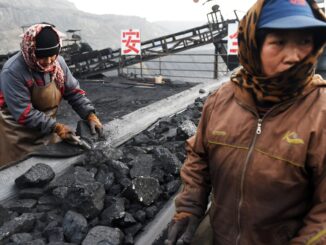
In 2024, Chinese investments in Brazil surged to $4.18 billion across 39 projects, marking a 113% increase from the previous year and positioning Brazil as the top emerging market for Chinese capital.
This influx, heavily concentrated in the energy and oil sectors, reflects Beijing’s strategic push to secure resources amid global energy transitions and geopolitical shifts. But why is China prioritizing Brazil, and what does this mean for the United States, Venezuela, and other oil-producing nations in South America? This article explores the drivers behind these investments and their broader ripple effects.
The United States’ Energy dominance is dependent on LNG exports, and producing more than we import. Energy Dominance can also include Energy Oil Field Service as an Export Service, and it appears we may now be behind the Chinese. And in our own backyard.
China’s Motivations: Securing Energy Security and Critical Resources
Are you Paying High Taxes in New Jersey, New York, or California?
China’s aggressive expansion into Brazil’s energy landscape is driven by a dual strategy: bolstering its energy security while advancing its role in the global clean energy supply chain. As the world’s largest energy consumer, China remains heavily reliant on fossil fuels to fuel its industrial growth, even as it leads in renewable deployments. In Brazil, this translates to investments in both oil and renewables, allowing China to diversify its import sources and reduce vulnerability to global supply disruptions.
Key deals underscore this approach. In the oil sector, Chinese firms have poured $1 billion into Brazil’s prolific pre-salt offshore basins in 2024 alone, building on a cumulative $77.5 billion invested since 2007 across 303 projects.
Major players like China National Petroleum Corporation (CNPC) and Sinopec hold stakes in these high-yield fields, aiming to boost production and secure heavy crude supplies similar to those from Venezuela. Simultaneously, renewables attract significant capital, with $1.43 billion directed toward solar and wind projects in 2024.
A notable transaction was the China Nonferrous Metal Mining Group’s (CNMC) $340 million acquisition of Mineração Taboca, targeting critical minerals like niobium and tantalum essential for electronics and clean energy technologies.
This strategy aligns with China’s Belt and Road Initiative (BRI), which saw oil and gas engagements skyrocket to over $30 billion in the first half of 2025 globally, up from $24 billion in all of 2024.
Brazil’s political stability under President Luiz Inácio Lula da Silva, combined with its leadership in renewables (90% of electricity from clean sources) and growing oil output, makes it an ideal partner.
For Brazil, these investments fuel economic growth, infrastructure development, and reindustrialization efforts, particularly in clean energy manufacturing.
Implications for the United States: Geopolitical Competition and Market Shifts
China moves into Venezuela with $1 BILLION floating oil facility
Operated by China Concord Resources Corp
‘Moving to RAMP up output at two key oilfields in western Venezuela’
Aiming to pump 60,000 barrels per day. pic.twitter.com/tK3REmHXZs
— RT (@RT_com) September 7, 2025
China’s deepening footprint in Brazil poses strategic challenges for the US, reshaping regional influence and global energy dynamics. As South America’s top trading partner, China has invested over $73 billion in Latin American energy since 2000, including refineries and processing plants.
This erodes US dominance in a region traditionally viewed as its “backyard,” heightening competition over resources and supply chains.On the oil market front, increased Brazilian production—potentially reaching new highs with Chinese backing—could stabilize global supplies but pressure prices, especially for heavy crudes that US refineries rely on.
China’s slowing oil demand growth in 2024, amid economic headwinds, might amplify this by reducing overall import needs, indirectly affecting US exporters.
Geopolitically, these investments fuel US concerns about energy weaponization and critical mineral dependencies, prompting policies like tariffs on Chinese clean energy products to counter Beijing’s dominance in solar, wind, and batteries.
Rising geopolitical risks, including US-China tensions, could further volatilize energy markets, with Brazil’s deals potentially diverting resources away from US-aligned partnerships.
The US has responded by reinvigorating its own investments in Latin America, but China’s head start in BRI projects gives it leverage in infrastructure and energy lending.
Ramifications for Venezuela and Chevron’s Operations
Venezuela, long a key oil supplier to China, faces indirect pressures from Beijing’s pivot toward Brazil. China’s $1 billion bet on Venezuelan oil in 2025 creates a “parallel energy corridor,” tying Caracas’s heavy crude to Chinese demand and diminishing US influence.
However, Brazil’s more stable and diversified opportunities may divert Chinese capital, reducing Venezuela’s bargaining power amid its ongoing economic crisis and sanctions.
This shift directly impacts Chevron, which resumed limited operations in Venezuela in 2025 under a US license, aiming to boost output and supply US refineries with heavy crude.
Increased Brazilian supply, backed by China, could ease global heavy crude tightness, potentially correcting prices and competing with Venezuelan exports.
Moreover, China’s regional dominance challenges Chevron’s position, as Beijing’s investments in alternative sources reduce reliance on Venezuelan oil, complicating Chevron’s revenue-sharing deals with the Maduro regime.
US tariffs on oil imports further strain Venezuela’s economy, potentially limiting Chevron’s expansion if political instability escalates.
Effects on Other South American Oil-Producers: A Double-Edged Sword
China’s Brazil-focused investments are part of a broader Latin American strategy, with implications for countries like Colombia, Ecuador, and Peru. In Peru, Chinese firms have invested in mega-projects like the Chancay port and lithium mining, enhancing logistics but raising sovereignty concerns over debt dependencies.
Ecuador and Colombia see similar patterns, with Chinese FDI in oil, renewables, and infrastructure totaling billions, boosting exports but exposing them to commodity price swings tied to China’s demand.
While these investments drive economic growth—such as $4.5 billion in regional lithium projects from 2019-2022—they create vulnerabilities.
A slowdown in China’s GDP or oil imports could depress prices, hitting resource-dependent economies hard.
Strategically, this fosters a “troubled energy triangle” with the US, where China’s control over critical minerals and energy routes amplifies geopolitical tensions.
Conclusion: A Reshaping of Global Energy Alliances
China’s billions in Brazil’s energy and oil sectors signal a long-term bid for resource dominance, blending fossil fuel security with clean energy ambitions. For the US, this heightens competition; for Venezuela and Chevron, it introduces market pressures and reduced leverage; and for other South American producers, it offers growth amid risks of dependency. As global energy transitions accelerate, these dynamics will test alliances and reshape supply chains, underscoring the need for diversified strategies in an increasingly multipolar world.
Note that the picture associated with the article shows a Chinese drilling rig being set up in Venezuela. As well as the fact that California imports 70% of the oil drilled in the Rain Forest of Equador from China. This is a real national security picture being drawn for the United States.
Avoid Paying Taxes in 2025
Crude Oil, LNG, Jet Fuel price quote
ENB Top News
ENB
Energy Dashboard
ENB Podcast
ENB Substack





